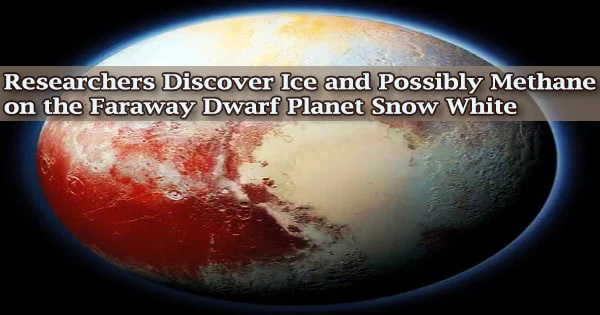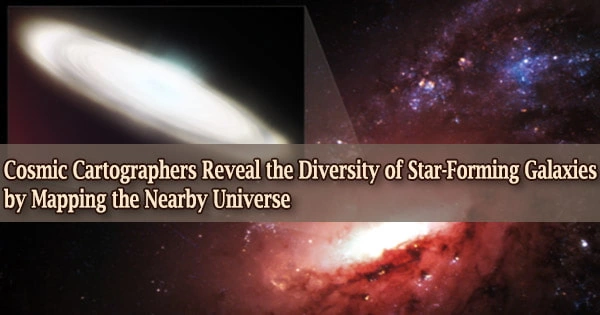The dwarf planet 2007 OR10, also known as Snow White, is an icy globe with roughly half of its surface covered in water ice that formerly flowed from ancient, slush-spewing volcanoes, according to astronomers at the California Institute of Technology (Caltech).
The latest discoveries also imply that a small layer of methane, possibly left over from an atmosphere that is slowly vanishing into space, may be present on the reddish dwarf planet.
“You get to see this nice picture of what once was an active little world with water volcanoes and an atmosphere, and it’s now just frozen, dead, with an atmosphere that’s slowly slipping away,” says Mike Brown, the Richard and Barbara Rosenberg Professor and professor of planetary astronomy, who is the lead author on a paper to be published in the Astrophysical Journal Letters describing the findings. The paper is now in press.
Meg Schwamb, a former graduate student of Brown’s, made the 2007 discovery of Snow White as part of her PhD thesis. Snow White is the fifth largest dwarf planet and orbits the sun near the fringe of the solar system. It is around half the size of Pluto.
Brown had mistakenly assumed at the time that it was an ice body that had detached from another minor planet called Haumea; he gave it the name Snow White due to his assumption that it was white.
However, subsequent studies soon showed that Snow White is actually one of the solar system’s reddest objects. At the furthest border of the solar system, there are a few other red dwarf planets. These far-off dwarf planets are a member of the Kuiper Belt Objects, a bigger collection of frozen worlds (KBOs).
As far as the researchers could determine, Snow White was an unimpressive dwarf planet that is simply one of over 400 putative dwarf planets that are among hundreds of thousands of KBOs, despite being relatively massive.
“With all of the dwarf planets that are this big, there’s something interesting about them they always tell us something,” Brown says. “This one frustrated us for years because we didn’t know what it was telling us.”
You get to see this nice picture of what once was an active little world with water volcanoes and an atmosphere, and it’s now just frozen, dead, with an atmosphere that’s slowly slipping away.
Mike Brown
According to Brown, the best tool astronomers had at the time to investigate KBOs was the Near Infrared Camera (NIRC) at the Keck Observatory, which Caltech professor of physics Tom Soifer and lead instrument scientist Keith Matthews helped construct in the 1990s.
But NIRC had just been retired, so no one could observe 2007 OR10 in detail. “It kind of languished,” he says.
Meanwhile, Adam Burgasser, a former graduate student of Brown’s and now a professor at UC San Diego, was helping to design a new instrument called the Folded-port Infrared Echellette (FIRE). Brown, Burgasser, and postdoctoral researcher Wesley Fraser used this instrument in conjunction with the 6.5-meter Magellan Baade Telescope in Chile last fall to examine 2007 OR10 in more detail.
Snow White was, of course, crimson. To their surprise, though, the spectrum showed that water ice was present on the surface.
“That was a big shock,” Brown says. “Water ice is not red.”
In the outer solar system, ice is prevalent, but it is virtually always white. Yet another dwarf planet, Quaoar, which Brown assisted in discovering in 2002, is both red and coated in water ice.
Quaoar, a somewhat larger planet than Snow White, had an atmosphere and a surface covered in volcanoes that spewed an icy slush that solidified as it flowed over the planet’s surface. However, due to its smaller size than dwarf planets like Pluto or Eris, Quaoar was unable to retain volatile substances like methane, carbon monoxide, or nitrogen for as long.
Quaoar started losing its atmosphere to space a few billion years after it originated; all that is left is a little amount of methane. The methane, which consists of a carbon atom bound to four hydrogen atoms, was eventually transformed into long, red-colored hydrocarbon chains by exposure to space radiation.
The methane that has been exposed to radiation rests on Quaoar’s frozen surface, giving it a rose hue similar to the frost that blankets a lawn on a frigid morning. The spectrum of 2007 OR10 resembles that of Quaoar, indicating that whatever occurred there also occurred on 2007 OR10.
“That combination of red and water says to me, ‘methane,’” Brown explains. “We’re basically looking at the last gasp of Snow White. For four and a half billion years, Snow White has been sitting out there, slowly losing its atmosphere, and now there’s just a little bit left.”
Brown claims that although the spectrum of Snow White plainly demonstrates the presence of water ice, the evidence for methane is still inconclusive. The astronomers will need to make use of a large telescope, like the one at the Keck Observatory, to find out.
If Snow White is found to contain methane, it will join Quaoar as one of only two dwarf planets that sit in between the small things that make up the vast bulk of KBOs and the few objects large enough to store volatile chemicals.
Giving the dwarf planet a formal name is another effort, according to Brown, as “Snow White” was only a moniker he and his colleagues used. In addition, the name no longer accurately describes this bright red object.
The astronomy community may have been satisfied with “2007 OR10” before to the discovery of water ice and the potential presence of methane because the object didn’t seem remarkable enough to require an official name.
“We didn’t know Snow White was interesting,” Brown says. “Now we know it’s worth studying.”
















